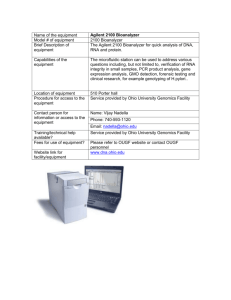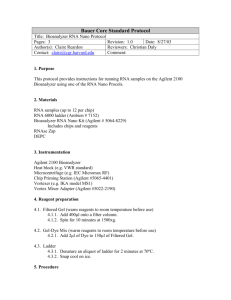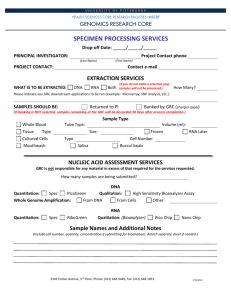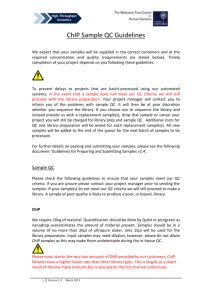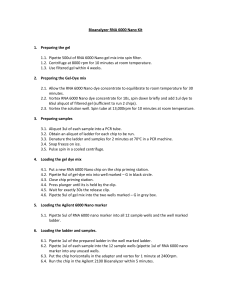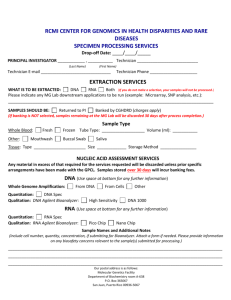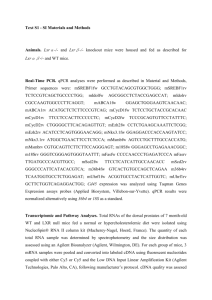Hamilton Regional Laboratory Medicine Program
advertisement
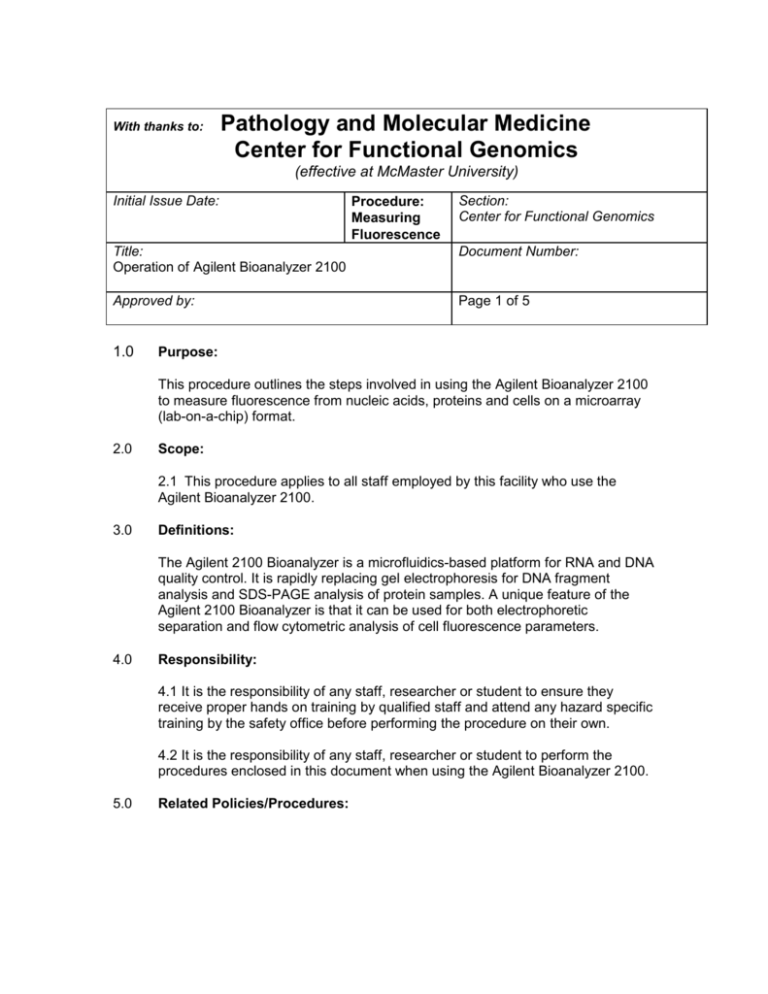
With thanks to: Pathology and Molecular Medicine Center for Functional Genomics (effective at McMaster University) Initial Issue Date: Procedure: Measuring Fluorescence Section: Center for Functional Genomics Title: Operation of Agilent Bioanalyzer 2100 Document Number: Approved by: Page 1 of 5 1.0 Purpose: This procedure outlines the steps involved in using the Agilent Bioanalyzer 2100 to measure fluorescence from nucleic acids, proteins and cells on a microarray (lab-on-a-chip) format. 2.0 Scope: 2.1 This procedure applies to all staff employed by this facility who use the Agilent Bioanalyzer 2100. 3.0 Definitions: The Agilent 2100 Bioanalyzer is a microfluidics-based platform for RNA and DNA quality control. It is rapidly replacing gel electrophoresis for DNA fragment analysis and SDS-PAGE analysis of protein samples. A unique feature of the Agilent 2100 Bioanalyzer is that it can be used for both electrophoretic separation and flow cytometric analysis of cell fluorescence parameters. 4.0 Responsibility: 4.1 It is the responsibility of any staff, researcher or student to ensure they receive proper hands on training by qualified staff and attend any hazard specific training by the safety office before performing the procedure on their own. 4.2 It is the responsibility of any staff, researcher or student to perform the procedures enclosed in this document when using the Agilent Bioanalyzer 2100. 5.0 Related Policies/Procedures: 6.0 Equipment RNase-, DNase-free equipment and surfaces RNaseZap, DNaseZap RNAase-free, DNase-free pipette tips, tubes and water Avoid sources of dust Lab Coat Sterile powder-free latex gloves Closed-toe shoes _____________________________________________________________________ 7.0 Action/Decision-making Framework: _____________________________________________________________________ PROCEDURE STEPS WORK INSTRUCTIONS 7.1 Pre-Use Check .1 Examine the electrical cord and make sure it is plugged into the instrument and the proper outlet. .2 Replace the syringe at the Chip priming Station with each new kit. .3 Adjust the base plate at the Chip Priming Station. .4 Adjust the syringe clip at the Chip Priming Station. .5 Adjust the Bioanalyzer’s chip selection .6 Set up the Vortex Mixer 7.2 Instrument Operation .1 Turn on the instrument power switch, and then turn on the computer. IMPORTANT: You will be prompted to enter your group’s password. This password confirms that someone in your group has been trained in the proper use of this equipment. RATIONALE To determine that the instrument is ready for use. To set the operating mode. .2 Open the 2100 Expert Software application; connect to the instrument and choose the assay protocol to be used. .3 For DNA and RNA electrophoretic assays do the following: - Insert the electrode cartridge and adjust the Bioanalyzer chip selector to position 1. - Prepare the loading gel by placing 550 L of nano gel matrix into a spin filter. To measure sample. PROCEDURE STEPS WORK INSTRUCTIONS - - - - - Centrifuge at 1,500 g for 10 min. Use filtered gel within 4 weeks. Mix 65 L of filtered gel with 1 L of dye concentrate. Vortex solution well and spin for 10 min. at room temperature at 13,000 g. Use the prepared gel-dye mix within one day. Take a new chip and place it in the Priming Station. Pipette 9 L of the gel-dye mix at the bottom of the well marked G and close the Priming Station for 30 seconds. Press the plunger until is held by the syringe clip. Wait for 30 seconds and release chip. Open the Chip Priming Station and pipette 9.0 L of gel-dye mix in the wells marked G. Pipette 5 L of RNA (DNA) nano marker in all 12 wells including the ladder well. Pipette 1 L of ladder into the well marked L. Load your samples by dispensing 1 L of sample in each of the 12 wells. Pipette 1 L of marker in each unused sample well. Put the chip in the adaptor and vortex for 1 min. at 2,400 rpm. Run the chip in the Agilent 2100 Bioanalzyer within 5 minutes. .4 For Cell Fluorescence Assays follow the guidelines outlined below: - Set up the instrument by inserting the pressure cartridge and adjust the chip selector to position 2. - Prepare the cells. Remove supernatant with a pipette tip and add the appropriate volume of cell buffer (green) to dilute to a final concentration of 2.0 million cells per mL. Re-suspend the cell pellet. Load the cells onto the chip after loading the chip priming solution, the focusing dye and cell buffer. - Load the chip priming solution. Pipette 10 L of the chip priming solution (white) into the large priming cell (PS). Wait for 60 seconds. RATIONALE PROCEDURE STEPS WORK INSTRUCTIONS - - - - 7.3 Shutting down the instrument. RATIONALE Load the focusing dye solution. Pipette 10 L of focusing dye solution (yellow) into the focusing well (FD). Loading the cell buffer. Pipette 30 L of cell buffer (green) into each of the 2 cell buffer wells (CB). Load the samples. Pipette 10 L of sample into each of the 6 sample wells (1-6). NOTE: If less than 6 samples are to be used, place 10 L of cell buffer into the empty sample wells. Insert a chip in the Bioanalyzer and close the lid. Run the assay by selecting the appropriate assay from the assay menu. Click the Start button. .1 When the assays are complete, remove chips from the Bioanalzyer. If RNA (DNA) chips were used, clean the electrodes with RNase(DNase-) free water for 10 seconds. If a cell assay chip was used, remove any liquid on the silicone gasket of the cartridge by using a soft tissue. . 2. Close the Bioexpert application on the computer. .3 Turn off the power to the instrument. .4 Record usage in the Log Book. .5 In the event of an expected power outage, turn off the Bioanalyzer. 7.4 TroubleShooting .1 Notify the person responsible for the unit, and make note of the problem in the Log Book. 7.5 Quality Control .1 The Bioanalyzer area should be maintained dust, RNase- and DNase-FREE. .2 Do not touch the Bioanalyzer during a run and never place it on a vibrating surface. .3 Never touch the instrument lens. Qualified persons must service this unit. PROCEDURE STEPS 7.6 Safety WORK INSTRUCTIONS .1 Laser light can harm eyes and damage skin. Do Not try to take measurements with the sample chamber open. .2 If trying to clean spillage in the sample chamber, unplug the unit to prevent any possibility of electrical shock. .3 Dispose of all samples according to good laboratory practices. 8.0 Documentation: All usage must be documented in the Log Book. 9.0 References: Agilent 2100 Bioanalyzer User’s Guide McMaster University: Risk Management Manual 2005 10.0 Developed By in Consultation With: Dr. Dora Ilieva (CFG Manager) Dr. John Hassell (Director of CFG) FHSc. Safety Office RATIONALE To ensure personal safety.
